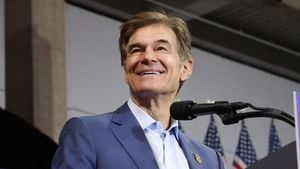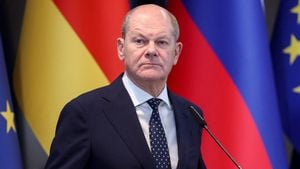Norway is back on the climate stage with bold declarations at the COP29 Climate Change Summit hosted in Baku. On November 19, Norway's Minister of Climate and Environment, Tore Onshuus Sandvik, underscored the importance of stepping up global efforts to combat climate change, emphasizing the need for decisive action across all fronts. His words echoed the sentiments shared by many at this international gathering, where the burning need for effective and actionable climate solutions has never felt more urgent.
Highlighting Norway's commitment, Sandvik focused on three pivotal areas of concern. First, he stressed the necessity for nations to present their commitments under the nationally determined contributions (NDCs) framework. This framework aims to keep global temperature rise below 1.5 degrees Celsius. "Every tonne counts. We need deep, rapid, and sustained emission reductions," Sandvik stated resolutely, adding, "We must come forward with our highest possible ambitions." Norway is setting its goals high, intending to align its new NDC with its Climate Change Act, which includes significant targets for 2035 to support the overarching goal of limiting global warming.
Another major concern echoed during Sandvik's address revolved around climate finance aimed at supporting developing countries. He argued for collective climate financing goals to be ambitious yet achievable, stating, "The new collective goal on climate finance needs to be ambitious and achievable and lead to more support of climate action in developing countries." Norway has pledged to mobilize substantial resources to align with long-term targets defined by the Paris Agreement, touting the importance of private sector investment as well.
“We can and must implement climate action,” he emphasized, advocating for this action to respect human rights, gender equity, and the rights and knowledge of indigenous peoples. Sandvik remains hopeful this COP29 will resonate with decision-makers globally, aiming to galvanize momentum for climate action.
Event backdrop matters, and COP29 is no exception. The summit kicked off against the complex backdrop of world politics, particularly involving the United States. Prior to the launch of COP29, the political climate thickened with concerns about the potential withdrawal of the US from the Paris Agreement following the recent US elections. This scenario has stoked anxiety over the country’s possible shift away from international climate initiatives once more.
Previously, the US under President Trump announced its exit from the Paris Agreement, which was realized on November 4, 2020. Although this decision was reversed under President Biden, the newly elected administration hinted at another potential exit. With the US being one of the largest greenhouse gas emitters, its leadership—or absence—resonates through the COP negotiations.
You might be wondering: what's the impact of such shifts? The stakes are high. The new president-elect's expressed intent to withdraw could threaten any progress made, overshadowing negotiations. The tension was palpable, as seen when Argentina pulled back its delegation during the first week of COP29, showcasing the ripple effect of these uncertainties.
Despite the uncertainty surrounding the US's engagement, other nations within the Paris Agreement are beginning to rally. The urgency for consolidated global action has been reaffirmed, as COP29 President Mukhtar Babayev called for courage from his fellow delegates to push past the stagnation seen all too often. "Be brave!" he urged, setting the tone for the upcoming negotiations.
But what does progress look like on the ground? COP29 is showcasing significant developments, especially concerning standards for the global carbon market. While early discussions hint at some degree of consensus, this path is fraught with challenges. The New Collective Quantified Goal on Climate Finance (NCQG) remains elusive, with many stakeholders clamoring for clarity and direction on climate funding to meet obligations under the Paris Agreement.
It’s not just high-level discussions at play; the discussions and negotiations taking place at COP29 are complex, with various nations vying for their interests. Amidst the negotiations, participants are grappling with how to agree on the necessary funding levels for climate actions, particularly against the backdrop of shifting political winds. The discussions on the NCQG have sparked concerns about equitable access to climate finance, particularly for the Global South, which remains the most vulnerable.
The emotional strains of climate change felt globally make it evident multiple voices are needed at the table—not just the voices of the elite but also those of individuals from impacted communities. Highlighting this, the Vice-President of the Heydar Aliyev Foundation, Leyla Aliyeva, participated actively at COP29, engaging in initiatives like juvenile fish releases to underline community involvement. Her contributions showcased grassroots movements within the overarching theme of climate action, emphasizing the importance of local efforts alongside international agreements.
The complexity of climate negotiations, including the overlap of politics and financing, continues to challenge delegates. Yet, through this struggle, the summit also serves as a platform for highlighting positive steps and innovations. A palpable enthusiasm for solutions emerged from various discussions, spotlighting countries like Azerbaijan, which have ramped up green energy production significantly this year, positioning themselves as contributors to the solution—not just victims of climate change.
For the next steps, COP29 holds great promise. The discussions are likely to intensify as decisions are made public. Reports of potential breakthroughs on significant issues could reinstate momentum among negotiators and stakeholders alike. The urging call from experts suggests focusing on tangible, actionable commitments from countries, particularly from larger emitters like the US and China, whose cooperation and ambition are deemed pivotal to the overall success of COP29.
With the days passing, and each discussion supplementing the collective experience of attendees, the message remains clear: the climate crisis requires bold action, strategic partnerships, and innovative solutions. The conversations at COP29 challenge delegates to remain optimistic yet grounded as they pursue climate justice and responsibility now and for future generations. The world is watching; the stakes couldn't be higher. Will the summit lead to meaningful commitments, or will it fade like so many before it? Only time will tell, as more discussions loom and expectations grow higher with each tick of the clock.



